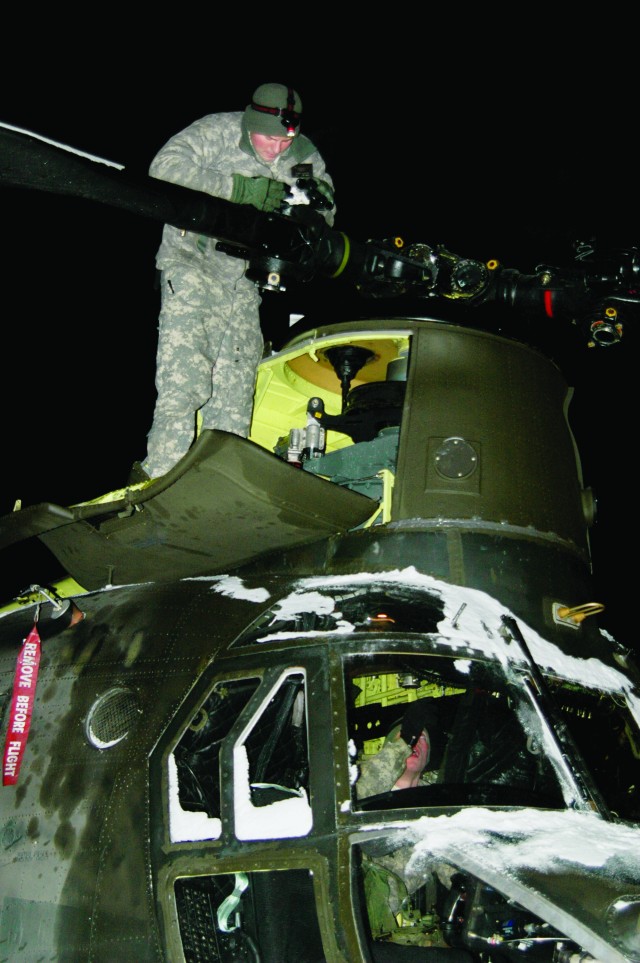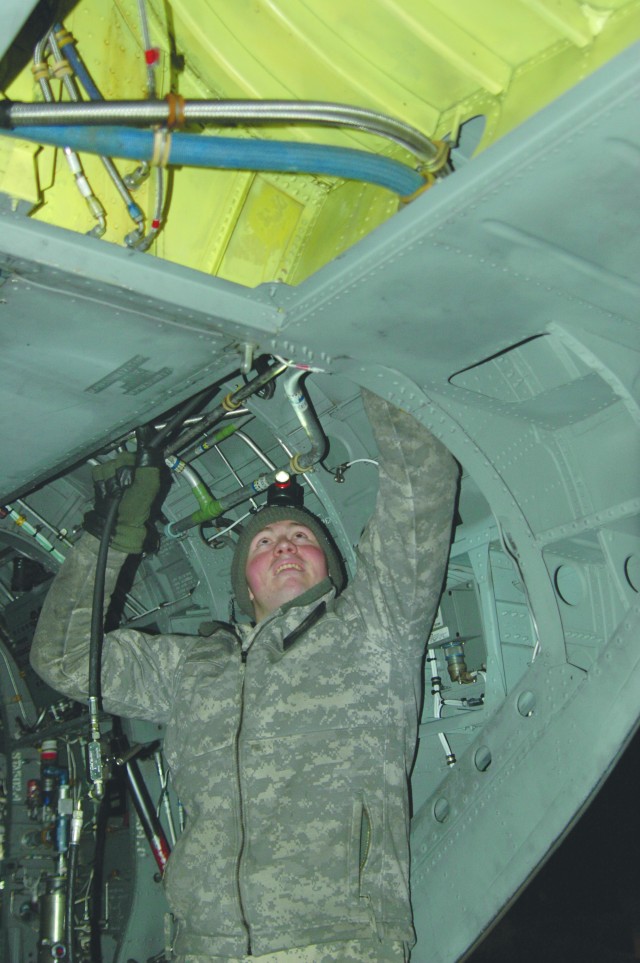FORT WAINWRIGHT, Alaska - A day in the life of a crew chief
By Sheryl Nix
Fort Wainwright PAO
Dramamine' Check. Saltine crackers' Check. Plastic bags in case the previous items don't do the job' Check. I was ready.
My mission that blustery February morning was to go behind the scenes and experience a typical day in the life of a crew chief. First Sgt. Steven R. Pritchett, B Company, 1st Battalion, 52nd Aviation Regiment, 16th Combat Aviation Brigade, first sergeant, graciously arranged for me to spend an entire day flying with an aircrew on board a CH-47 Chinook from B/1-52nd, as it trained in a mixed, multi-ship formation with another Chinook and a UH-60 Blackhawk from D Company, 123rd Aviation Regiment, 1-52nd, 16th CAB, for the upcoming rotation at the National Training Center at Fort Irwin, Calif.
After a quick introduction, Spc. Jason Burdeaux, crew chief on my flight, took off toward the flightline, rattling off significant facts about the different Chinooks in the hangar while I tried to keep up. I soon realized that his day had begun much earlier than mine and that was the norm. He had actually taken a break from "dailying" the aircraft, or doing the first inspection, to come meet me at 7 a.m.
Outside, he and Sgt. Owen Cunningham, flight engineer, continued "dailying" the aircraft, getting fuel and working with the pilots on preflight inspections. While I fumbled with my cameras, notepad and equipment in the cold and darkness in front of Hangar 1, Burdeaux and Cunningham climbed all over the Chinook like real-life versions of Spider Man.
They opened every panel and compartment on the inside and outside of the aircraft as if their lives depended on it. Actually, I guess their lives did and do depend on their thoroughness. Most crew chiefs are former maintenance technicians, hand-picked to do this demanding work, and are no strangers to the ins and outs of their helicopters. Pilots and passengers depend on them to spot safety issues and resolve them and if the crew chief and flight engineer say it's safe, pilots take their word for it.
That says a lot about the type of team forged on these long days of flying and the dependency they share with one another.
"These guys are consummate professionals," said Chief Warrant Officer 2 Malcolm Jennings, pilot in command of our aircraft, describing the role of crew chiefs and flight engineers."We can't do our mission without them. They're a real vital part of our crew."
After the crew brief and run up, which is basically starting the engines, we took off for the NTC training. Burdeaux worked the entire flight, checking hoses, connections, levels, and assisting the pilots as they maneuvered and landed.
Switching pilots and then running a few aircrew training missions was next on the agenda and finally, more than 10 hours after their day began, we were back in front of Hangar 1. Crewmembers conducted post-flight inspections to check fluid levels, pressures and buttons and to be certain that the aircraft was ready to fly the next day.
While their day was still not over, closing out the flight plan and paperwork awaited them inside the hangar, I was exhausted and ready to go home. But I had to know - how do they do this day in and day out, or maybe a better question was, why do they do it'
"I love to fly," Burdeaux said. He and Cunningham said the long hours and other demands of their jobs pale in comparison with the rewards.
"Every day is a little bit different," Cunningham said. "Yeah, you're doing the same thing, but at the same time you're not, because every day the environment is a little different. The flying conditions are a little different or you're working on something different. It's not the monotonous day-to-day grind."
They went back to work after our interview, discussing the flight with their pilots and assisting the other teams with their work since, according to Cunningham, "We all showed up together, we're all going to leave together." I left, exhausted and still reeling from all I had experienced that day. It may sound a little hokey, but I think that experience changed me a bit. I no longer merely glance up as I see Chinooks flying across post. I now pause and remember and appreciate.
Thank you, Sugar Bears. I had a blast, learned so much and have an entirely new appreciation for the hard work, long hours and tireless professionalism of crew chiefs, flight engineers, pilots and the entire B/1-52nd community. I would fly with you any day.




Social Sharing